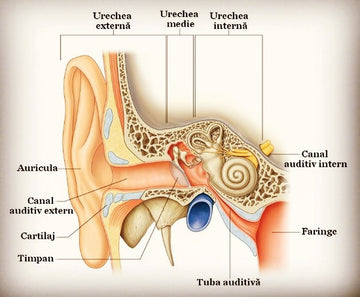The external auditory canal and the most common health problems
by Sebastian Calin on Dec 19, 2024

1. What is the external auditory canal?
The external auditory canal (EAC) is an S-shaped osteo-cartilaginous canal that extends from the pinna (auricle) to the tympanic membrane. It is made up of two parts:
- One third cartilaginous (close to the external opening).
- Two-thirds bony (towards the inside, towards the eardrum).
Its main function is to conduct sound waves to the eardrum, where sound vibrations are transformed into mechanical signals.
2. The most common health problems associated with the external auditory canal:
2.1. Congenital problems
- Atresia of the external auditory canal : Partial or complete absence of the auditory canal.
- It can be isolated or associated with dysplasia of the middle or inner ear.
- Requires imaging evaluation (HRCT) for surgical planning and identification of possible contraindications (e.g. atretic oval or round window).
2.2. Inflammatory problems
- Malignant external otitis :
- It is an aggressive infection caused by Pseudomonas aeruginosa , common in the elderly or diabetic patients.
- It can affect surrounding structures (temporal bone, temporomandibular joint).
- It requires antibiotic treatment and prompt management to prevent severe complications.
- Diagnostic imaging (CT) helps to assess the extent.
2.3. Tumors and neoplastic lesions
- Osteochondroma (exostosis) :
- Benign tumor frequently found in EAC.
- Benign tumors are usually asymptomatic and slow-growing.
- Malignant tumors include osteosarcoma, squamous cell carcinoma, etc.
- Gardner syndrome : Association of multiple osteomas with colon polyps and other systemic abnormalities.
2.4. Traumatic problems
- Blunt or penetrating injuries :
- Frequently caused by road accidents, they can affect the external auditory canal and adjacent structures, such as the temporomandibular joint.
- HRCT images are useful for identifying hematomas, bone fractures, and possible dislocations.
2.5. Functional problems and obstructions
- Impaction of cerumen (ear wax) :
- Excessive wax buildup can lead to canal obstruction and symptoms such as temporary hearing loss.
- It is considered problematic only when it affects clinical assessment or causes discomfort.
2.6. Cholesteatoma of the external auditory canal
- Proliferation of stratified squamous epithelium in the external auditory canal or middle ear.
- Primary cases are rare, and secondary ones are frequently associated with trauma or chronic inflammation.
- Requires surgical intervention and imaging monitoring (CT).
3. The importance of diagnosis and treatment
- Most problems of the external auditory canal can be diagnosed clinically, but imaging (high-resolution CT) is essential to assess severity, extent, and for treatment planning.
- Prompt treatment of conditions (such as malignant otitis externa or bone tumors) is crucial to avoid complications that can affect adjacent structures, such as the middle ear, skull base, or temporomandibular joint.
By understanding the functions and common problems associated with the external auditory canal, prevention and prompt management of complications become more effective.




